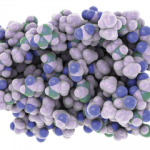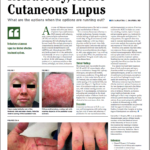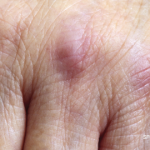The review includes an image depicting the similarities and differences between cutaneous lupus erythematosus and dermatomyositis.
Potential Therapies
No therapies approved by the U.S. Food & Drug Administration exist for the treatment of cutaneous lupus erythematosus or skin disease in dermatomyositis.
Several monoclonal antibodies and small molecule inhibitors to target the type I IFN signaling pathway are under development. These “promising new avenues for treatment” include therapies targeting IFNα or IFNβ, interferon-α/β receptor alpha chain (IFNAR), plasmacytoid dendritic cells, toll-like receptors (TLRs) and their downstream IFN signaling pathways, including Janus kinase (JAK) inhibitors and tyrosine kinase 2 (TYK2) inhibitors.
The authors also discuss the cannabinoid receptor type 2 agonist lenabasum, noting a clinical trial of its efficacy and safety. “The degree and consistency of clinical benefit, combined with a favorable safety profile, warrant further evaluation of lenabasum for skin predominant dermatomyositis,” they write.
A detailed figure summarizes the type I IFN signaling pathway, disease triggers and mechanisms of new therapeutics, while a table incorporates the emerging therapies in cutaneous lupus erythematosus and dermatomyositis.
“Skin only, skin predominant and post-myopathic skin disease in dermatomyositis is more common than previously reported,” Dr. Werth concludes. “Clinicians play an important role in advising patients of the immunostimulatory properties of several herbs that show differential activation of immune cells in dermatomyositis relative to normal controls. Current and ongoing trial data mostly require active myositis, excluding patients with predominantly skin disease, and this often limits the ability to get access to medications covered for those with muscle disease that would also work for the skin findings of dermatomyositis.”
Katie Robinson is a medical writer based in New York.
References
- Bucala R, Solomon DH. Immunology for the rheumatologist: Arthritis & Rheumatology introduces a new problem-based immunology review series with great educational potential. Arthritis Rheumatol. 2024 Jan;76(1):9–10.
- Hile GA, Werth VP. Understanding the role of type I IFN in cutaneous lupus and dermatomyositis: Towards better therapeutics. Arthritis Rheumatol. 2024 Sep 11.


